Chapter 16/17 test cards
1/47
Earn XP
Name | Mastery | Learn | Test | Matching | Spaced |
|---|
No study sessions yet.
48 Terms
What is evolution?
The process by which organisms have changed over time.
It is the process of change over time. Biological evolution explains how modern organisms evolved over long periods of time through descent from common ancestors.
What is a fossil?
The preserved remains of ancient organism
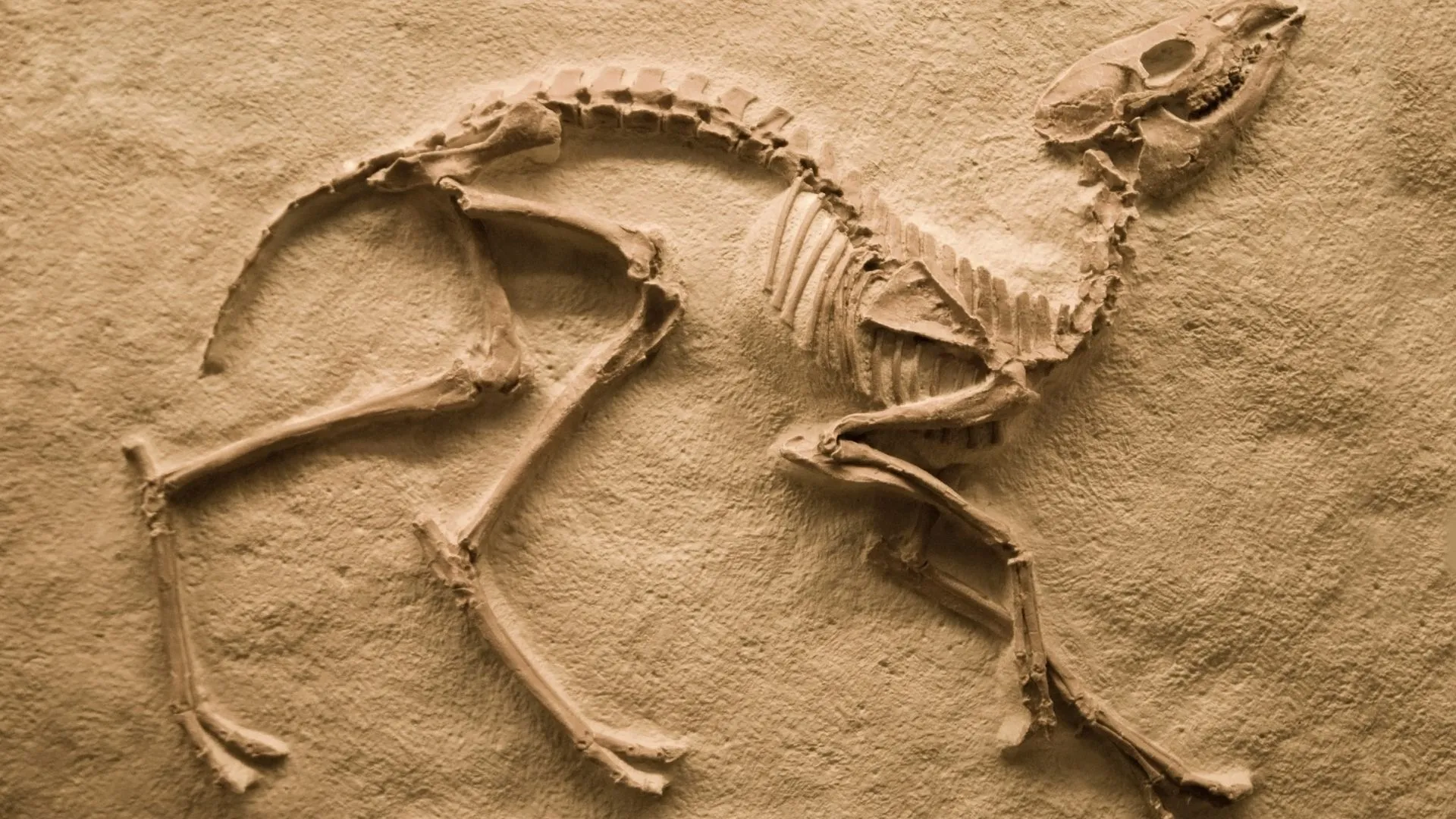
What was Charles Darwin's main contribution to science?
He developed a scientific theory of biological evolution that explains how modern organisms evolved over long periods of time through descent from common ancestors.
He developed the central idea of evolution by natural selection.
What is natural variation?
Differences among individual members of a population.
The occurrence of natural variations is a critical part of Charles Darwin's theory of evolution by natural selection.
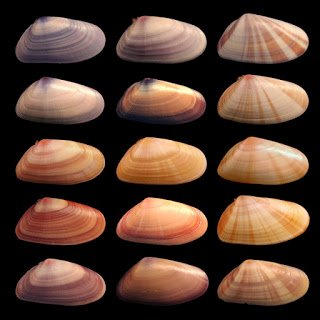
What is natural selection?
The process by which organisms with variations most suited to their local environment survive and leave more offspring.
It is a process in nature that operates like artificial selection. The environment, not a farmer or animal breeder, influences fitness in natural selection.
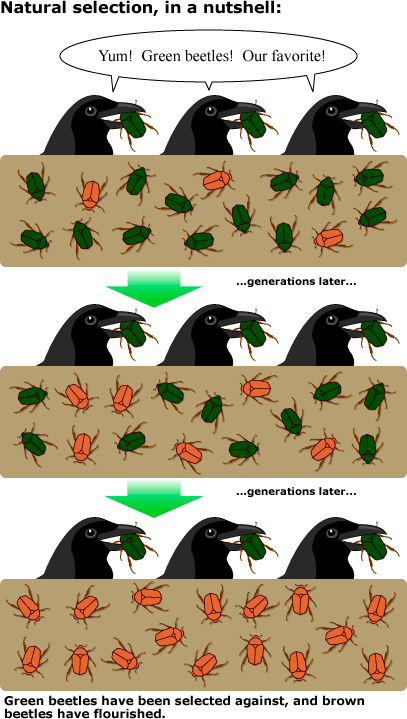
What is an adaptation?
Any heritable characteristic that increases an organism’s ability to survive and reproduce in its environment.
Adaptations can involve body parts, structures, colors, physiological functions, or behaviors.
What is fitness (in evolutionary terms)?
How well an organism survives and reproduces in its environment.
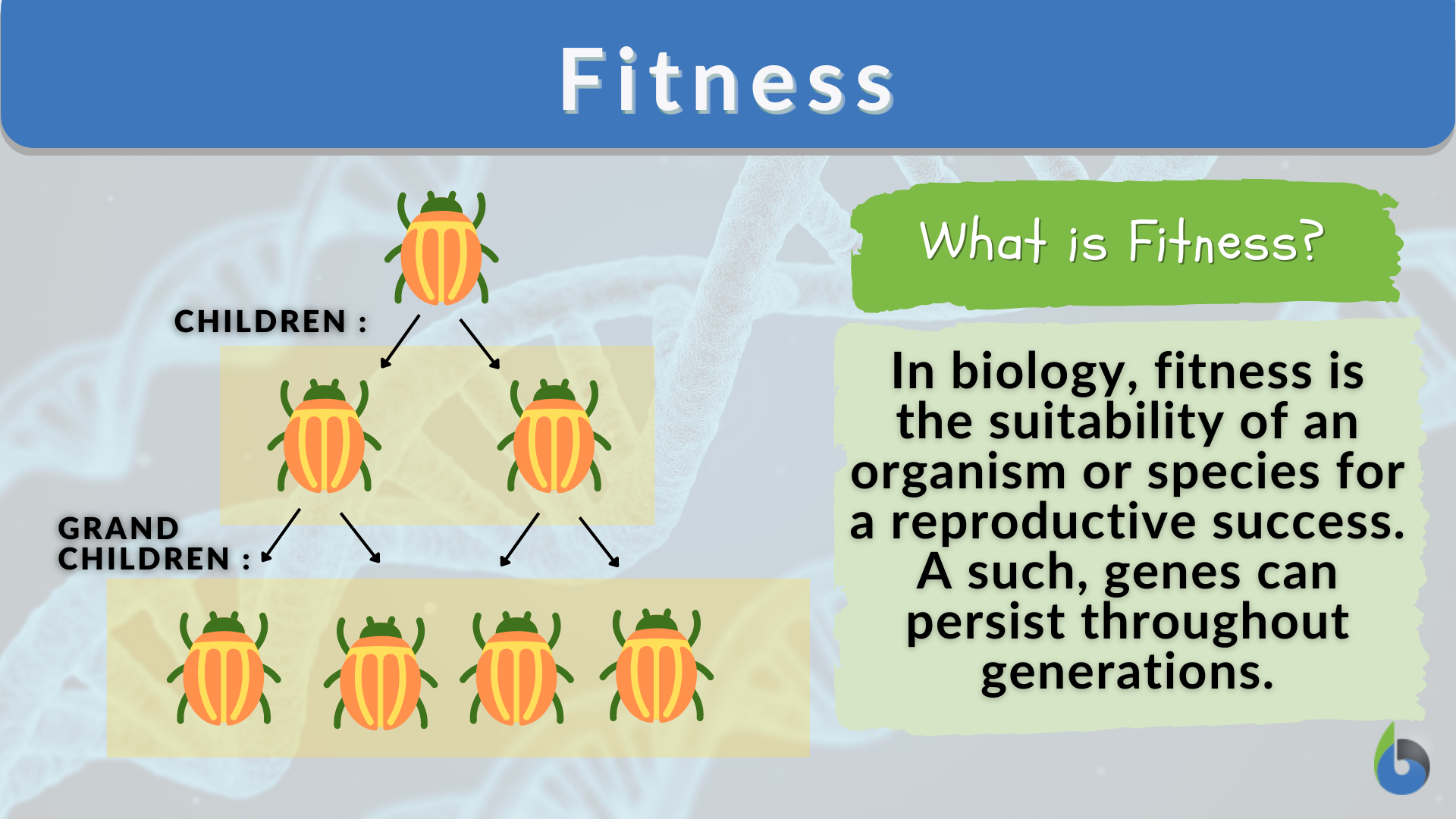
What is a gene pool?
The combined genetic information of all members of a particular population.
It consists of all the genes, including all the different alleles for each gene, that are present in a population.
What is allele frequency?
The number of times an allele occurs in a gene pool, compared to the total number of alleles in that pool for the same gene.
What patterns of biodiversity did Darwin note on his voyage?
Species vary globally, species vary locally, and species vary over time.
What does "species vary globally" mean?
Different, yet ecologically similar, animal species inhabited separated, but ecologically similar, habitats around the globe.
For example, rheas in South America, ostriches in Africa, and emus in Australia.
What does "species vary locally" mean?
Different, yet related, animal species often occupied different habitats within a local area.
Example- different tortoises on the Galápagos Islands had different shell shapes suited to the vegetation on their island.
What does "species vary over time" mean?
Some fossils of extinct animals were similar to living species.
Example- Darwin found fossils of the extinct glyptodont that were similar to living armadillos.
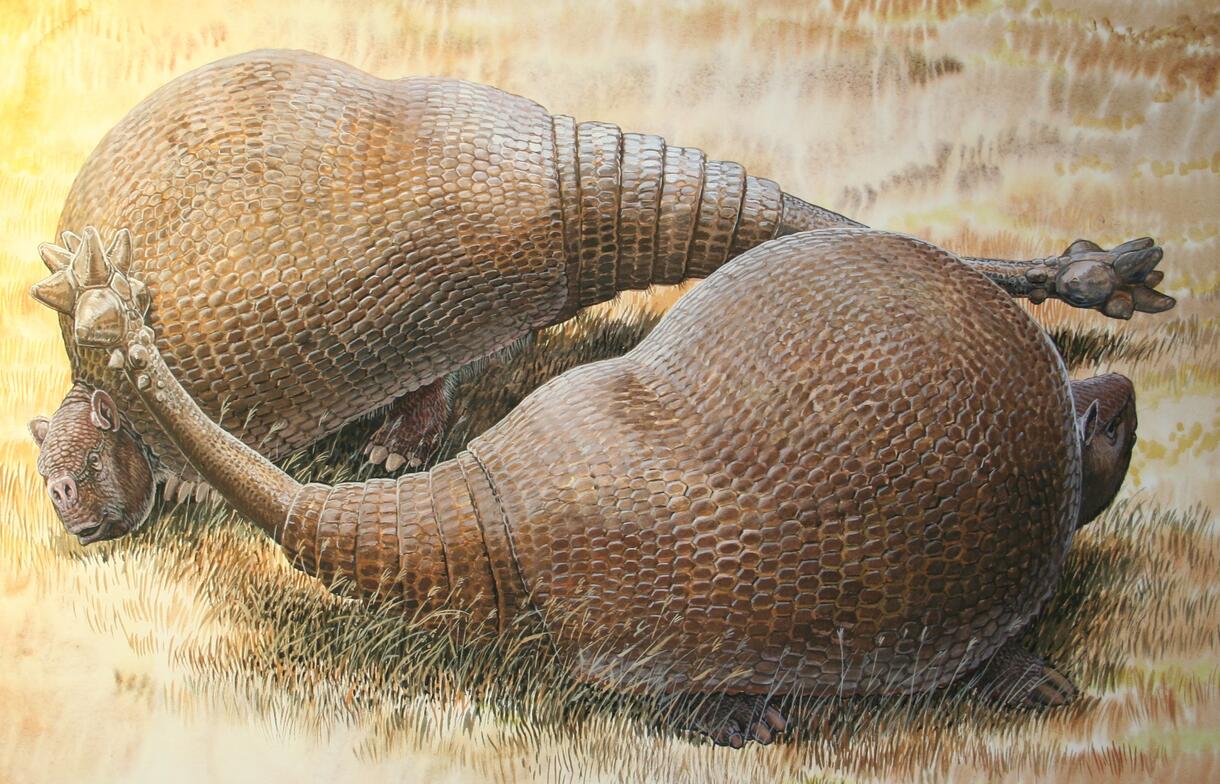
How did the ideas of geologists James Hutton and Charles Lyell influence Darwin?
They suggested that Earth was ancient and had changed over time.
extra info—-
Lyell's Principles of Geology influenced Darwin because it proposed that Earth is extremely old and processes that changed Earth in the past are still at work today. This provided the great time span Darwin believed was necessary for evolution to occur and offered a geological analogy for biological evolution.
What was Jean-Baptiste Lamarck's hypothesis about evolution?
He hypothesized that organisms could acquire traits during their lifetime by selectively using or not using their body parts and pass these acquired characteristics on to their offspring.
extra info-
He also suggested that organisms have an innate tendency toward perfection. His ideas about how traits are acquired and passed on have been proved wrong.
What were Thomas Malthus's ideas about population growth?
He reasoned that if the human population grew unchecked, there wouldn't be enough living space and food for everyone.
MORE Info-
He believed population growth was limited by overcrowding and lack of food, and that these factors apply to other organisms better than humans.
How did Malthus influence Darwin?
Malthus's ideas about limiting factors on population growth influenced Darwin's thinking about survival.
Darwin realized that Malthus's reasoning applied to most organisms, not just humans.
What is artificial selection?
A process in which nature provides the inherited variations, and humans select those traits that they find useful.
Darwin used artificial selection in breeding fancy pigeons.
How is artificial selection similar to and different from natural selection?
Both processes change the heritable traits of a population over time. In both, organisms with certain traits are more likely to survive and reproduce.
However, in artificial selection, a breeder or farmer decides which organisms reproduce.
whereas in natural selection, environmental conditions determine which organisms reproduce.
What are homologous structures?
Structures that are shared by related species and that have been inherited from a common ancestor.
They have different mature forms but develop from the same embryonic tissue. They may have different functions but similar structures.
What are analogous structures?
Body parts that share a common function, but not structure.
Examples are the wing of a bee and the wing of a bird.
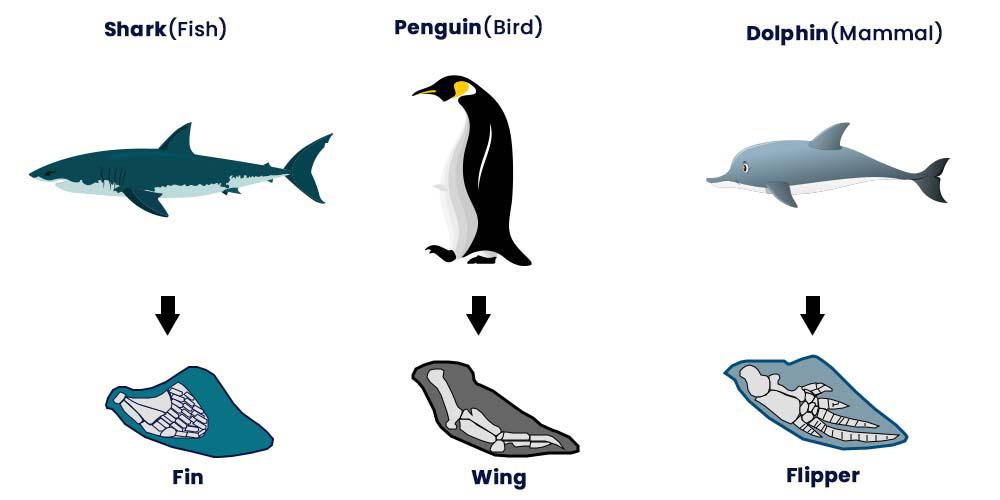
What are vestigial structures?
Inherited from ancestors but have lost much or all of their original function due to different selection pressures.
An example is the hipbones of a bottlenose dolphin. They indicate that present-day organisms are different from their ancient ancestors because these features are remnants of structures that functioned in the organism’s ancestors.
How does molecular biology provide evidence for evolution?
Similarities in the DNA sequences of genes can be used to determine how closely two species are related.
Homologous proteins, like cytochrome c, found in many different organisms, show extensive structural and chemical similarities. The more similar the genes are, the more recently the species shared a common ancestor
How is evolution defined in genetic terms?
Evolution is any change over time in the allele frequency in a population.
What are the main sources of genetic variation?
Mutation, genetic recombination during sexual reproduction, and lateral gene transfer.
What is a mutation?
Changes in the genetic material of a cell. Mutations can be neutral, beneficial, or harmful.
How does sexual reproduction increase genetic variation?
Through genetic recombination, which occurs during meiosis and includes crossing-over.
extra info-
Genetic recombination shuffles alleles, producing many possible gene combinations. Any of these combinations from one parent may unite with any combination from the other parent, increasing diversity.
What is lateral gene transfer?
The passing of genes from one organism to another organism that is not its offspring. It can occur between organisms of the same species or different species.
What determines the number of phenotypes for a trait?
How many genes control the trait.
What is a single-gene trait?
A trait controlled by only one gene.
Single-gene traits may have just two or three distinct phenotypes
What is a polygenic trait?
A trait controlled by two or more genes.
What is directional selection?
Occurs when individuals at one end of the curve have higher fitness than individuals in the middle or at the other end.
The range of phenotypes shifts because some individuals fail to survive and reproduce
What is stabilizing selection?
Occurs when individuals near the center of the curve have higher fitness than individuals at either end.
What is disruptive selection?
Occurs when individuals at the upper and lower ends of the curve have higher fitness than individuals near the middle.
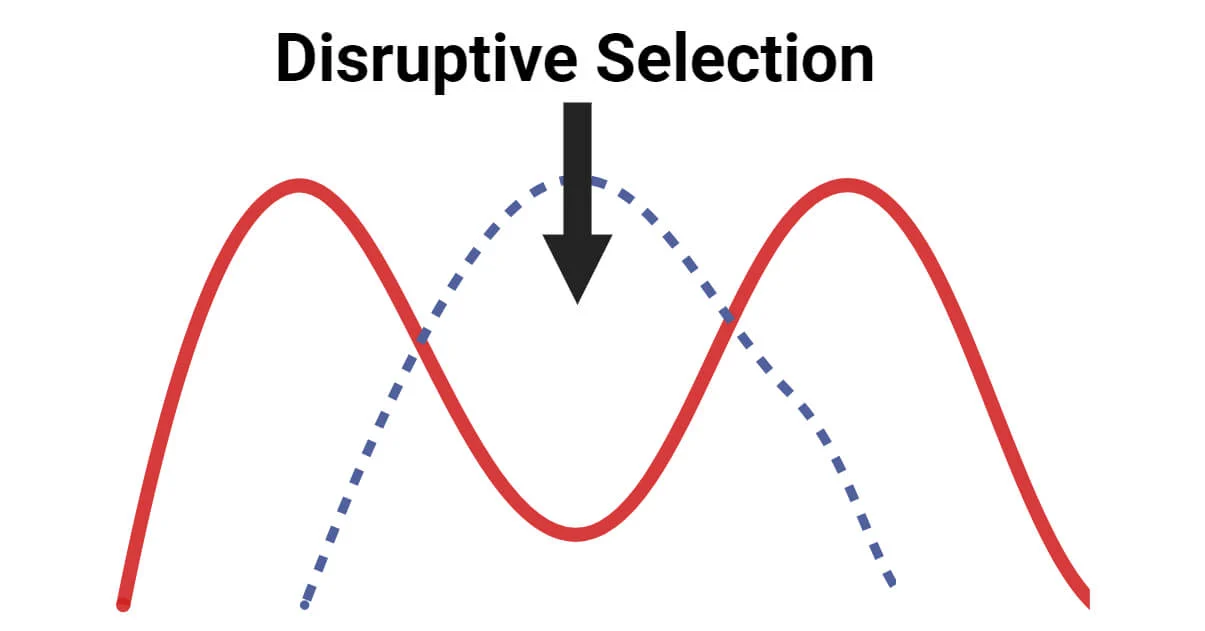
What is genetic drift?
Random change in allele frequency. In small populations, chance occurrences can cause an allele to become more or less common over time.
What is the bottleneck effect?
A change in allele frequency following a dramatic reduction in the size of a population.
A disaster might kill many individuals, leaving a small population whose gene pool may not accurately represent the original population.
What is the founder effect?
A situation in which allele frequencies change as a result of the migration of a small subgroup of a population.
The new population, or "founding population," might have different allele frequencies from the original population, just by chance.
What is genetic equilibrium?
A situation in which allele frequencies in a population remain constant.
If allele frequencies don't change, the population will not evolve.
What conditions are required to maintain genetic equilibrium (Hardy-Weinberg Principle)?
1. Random mating;
2. Large population size;
3. No migration (no gene flow);
4. No mutations;
5. No natural selection. If these conditions are not met, a population will evolve.
What is a species?
A population or group of populations whose members can interbreed and produce fertile offspring.
What is speciation?
The formation of a new species.
What is reproductive isolation?
When two populations no longer interbreed.
Once reproductive isolation occurs, the populations have separate gene pools and can evolve into different species.
What are the types of reproductive isolation that can lead to speciation?
Behavioral isolation, geographic isolation, and temporal isolation.
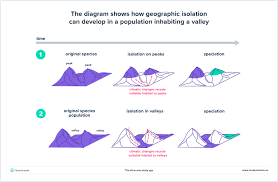
What is behavioral isolation?
Occurs when two populations that are capable of interbreeding develop differences in courtship rituals or other behaviors.
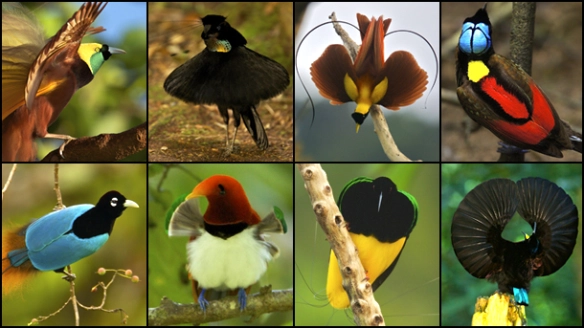
What is geographic isolation?
Occurs when two populations are separated by geographic barriers such as rivers, mountains, or bodies of water.
What is a gene family?
A group of related genes that resulted from the duplication and modification of a single gene.
Members of a gene family typically produce similar, yet slightly different, proteins.
What is a molecular clock?
A technique that uses mutation rates in DNA to estimate the time that two species have been evolving independently.
How may Hox genes be involved in evolutionary change?
Small changes in Hox gene activity during embryological development can produce large changes in adult animals.
Hox genes control the development of body plans and structures.
For example, mutations in a single Hox gene (Ubx) contributed to the difference in leg number between insects and crustaceans.